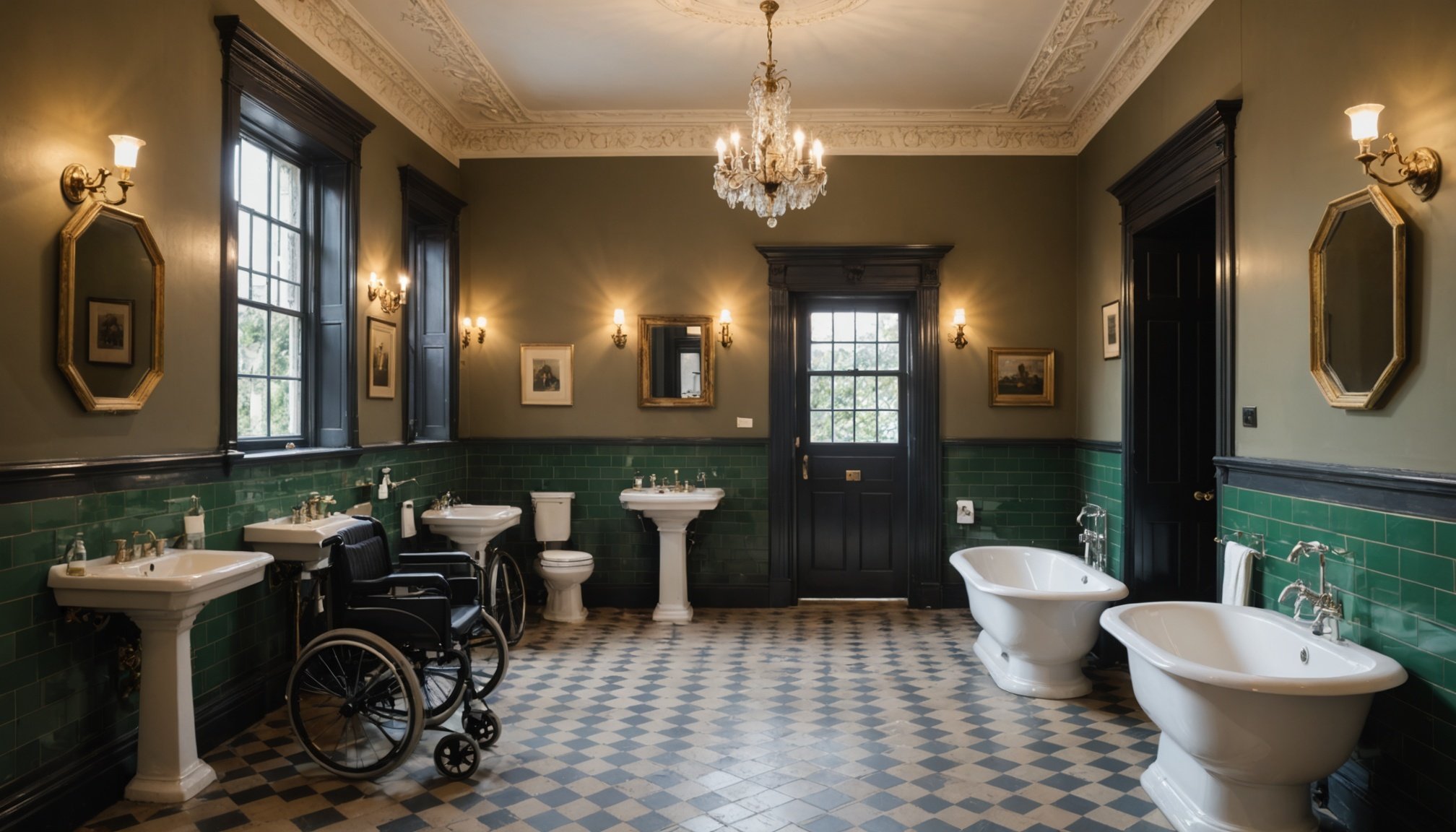Historic buildings often face unique challenges when it comes to accessibility. Designing wheelchair-accessible bathrooms in these spaces is essential for inclusivity. This guide offers practical strategies and innovative solutions tailored for UK heritage sites. By balancing preservation with modern standards, we can create spaces that welcome everyone, ensuring that history remains accessible. Discover how thoughtful design can transform these landmarks while respecting their rich history.
Understanding Wheelchair Accessibility in Historic Buildings
Navigating the complexities of wheelchair accessibility in historic buildings poses unique challenges. These spaces, often characterised by narrow corridors, uneven floors, and steps, can be difficult to modify without compromising their historical integrity. The UK regulations mandate that reasonable adjustments should be made to improve accessibility while respecting the architectural heritage. This balance is crucial, as historic buildings contribute significantly to cultural identity and tourism.
Dans le meme genre : Smart Strategies for Minimizing Household Waste in UK Urban Dwellings
Adhering to UK regulations involves implementing solutions such as ramps, lifts, or alternate routes, ensuring that accessibility does not detract from the building's historical value. For example, installing a lift may require careful planning to avoid altering the building's facade or structure.
The importance of compliance with these regulations is twofold: it ensures that individuals with mobility impairments can access and enjoy these cultural landmarks, and it also aligns with broader societal goals of inclusivity and equality.
En parallèle : Unlocking Fresh Air: Proven Natural Ventilation Strategies to Eliminate Dampness in UK Basements
Preservation efforts must consider modern accessibility needs without undermining the building's historical aspects. By employing innovative design solutions, it is possible to achieve a harmonious balance between maintaining the heritage and ensuring accessibility for all.
Relevant UK Regulations and Standards
Navigating the UK building regulations is crucial for enhancing accessibility in historic buildings. Key legislation, such as the Building Regulations Part M, plays a pivotal role. This regulation mandates that reasonable provisions must be made to ensure that buildings are accessible and usable. It focuses on making both new and existing structures accessible, with specific guidance on entrances, corridors, and facilities.
The Equality Act 2010 further supports accessibility by prohibiting discrimination against individuals with disabilities. It requires that service providers, including those managing historic sites, make reasonable adjustments to accommodate all users. This act ensures that equal access is not just a recommendation but a legal obligation.
Understanding these accessibility standards is vital for compliance and preservation. While the regulations aim to improve access, they also respect the unique characteristics of historic buildings. For instance, solutions like removable ramps or temporary structures can be employed to meet accessibility needs without permanent alterations. By adhering to these standards, stakeholders can ensure that historic sites remain both culturally significant and inclusive, welcoming all visitors regardless of mobility challenges.
Design Strategies for Wheelchair-Accessible Bathrooms
Creating wheelchair-accessible bathrooms involves thoughtful design strategies that cater to the needs of all users while respecting the space's limitations.
Spatial Planning and Layout
Effective spatial planning is crucial. Bathrooms should offer ample space for wheelchair manoeuvrability, including turning circles of at least 1500mm in diameter. This ensures users can navigate easily without obstruction. Locating essential features, such as sinks and toilets, within reach enhances accessibility.
Fixtures and Fittings
Selecting the right fixtures and fittings is vital for functionality. Consider installing wall-mounted sinks at a lower height and lever-operated taps for ease of use. Grab rails near toilets and showers provide additional support, fostering independence. Ensure these installations meet safety standards and are securely fixed.
Signage and Wayfinding
Clear signage and wayfinding are essential in guiding users effectively. Signage should be visible, with high contrast and tactile elements to aid those with visual impairments. Consistent symbols and directions help users easily locate facilities, enhancing their overall experience.
By integrating these design strategies, bathrooms can become inclusive spaces that accommodate everyone’s needs, promoting dignity and independence.
Case Studies of Successful Renovations
Exploring case studies of successful renovations provides valuable insights into creating accessible bathrooms in historic buildings. These examples highlight the best practices that balance accessibility with heritage preservation.
Examples of Historic Bathroom Renovations
One notable case is the renovation of the Royal Opera House in London. This project maintained the building's historical charm while incorporating modern accessible bathroom designs. The use of removable ramps and discreetly installed lifts ensured accessibility without altering the building's facade.
Another example is the Edinburgh Castle, where careful spatial planning allowed for the installation of accessible bathrooms. The project team employed innovative solutions like foldable grab rails and wall-mounted fixtures to maximise space and functionality.
Lessons Learned and Best Practices
From these projects, several lessons emerge. First, involving accessibility experts early in the design process is crucial. This ensures that best practices are integrated, such as using non-slip flooring and ensuring adequate lighting. Additionally, maintaining open communication with stakeholders helps balance accessibility needs with preservation goals.
By studying these case studies, designers can adopt successful strategies, ensuring that historic buildings remain both accessible and true to their heritage.
Historical Preservation Considerations
Preserving the historical integrity of heritage buildings while enhancing accessibility is a delicate balance. Key historical preservation principles guide these efforts, ensuring that any modifications respect the building's original character. These principles focus on maintaining the aesthetic, cultural, and architectural significance of a site.
To achieve this balance, employing conservation practices is crucial. These practices involve using materials and techniques that align with the building's era, ensuring any additions or changes are sympathetic to its original design. For instance, when installing modern amenities, using reversible or non-invasive methods can prevent permanent alteration.
Collaborating with conservation experts is essential for successful projects. These professionals bring invaluable insights into compliance with preservation standards and offer innovative design solutions that honour the building's heritage. By working closely with these experts, stakeholders can ensure that both accessibility and historical preservation goals are met.
Incorporating these strategies not only safeguards the historical preservation of heritage buildings but also enhances their accessibility. This approach ensures that these cultural landmarks remain relevant and functional for future generations, while still celebrating their rich histories.
Accessibility Best Practices
Incorporating accessibility best practices into bathroom design is essential to meet the needs of all users. Effective design guidelines ensure that spaces are not only functional but also enhance the overall user experience.
Key Best Practices
- Space Utilisation: Ensure ample space for wheelchair manoeuvrability, with turning circles of at least 1500mm in diameter.
- Fixtures and Fittings: Install wall-mounted sinks at a lower height and lever-operated taps for ease of use.
- Safety Features: Include grab rails near toilets and showers to provide additional support.
Importance of User Feedback
User feedback is crucial in refining design guidelines. Engaging with individuals who have mobility challenges offers insights into practical needs and preferences, ensuring that designs are both effective and empathetic. This feedback loop helps identify potential improvements and enhances the user experience.
Resources for Ongoing Training
Continual learning is vital for maintaining high standards in accessibility. Resources like online courses, workshops, and seminars offer valuable training. These platforms keep designers updated on the latest accessibility best practices and innovations, ensuring that facilities remain inclusive and effective.
Resources for Further Assistance
Navigating the complexities of accessibility in historic buildings can be daunting. Fortunately, numerous resources are available to assist stakeholders in making informed decisions.
Expert Contacts and Organizations
Several organizations provide invaluable guidance on heritage and accessibility. The Heritage Lottery Fund and Historic England offer expert advice and funding opportunities for projects involving historic sites. Additionally, the Centre for Accessible Environments provides consultancy services to ensure compliance with accessibility standards.
Recommended Materials and Suppliers
Selecting the right materials is crucial for successful renovations. Suppliers like Altro and Forbo offer non-slip flooring options, essential for safe and accessible bathrooms. For fixtures, companies such as Armitage Shanks provide a range of accessible bathroom fittings designed to blend seamlessly with historic interiors.
Publications and Online Resources
Staying informed is key to effective design. Publications like "Conservation Principles" by Historic England offer insights into maintaining the historical integrity of buildings. Online platforms, including the Access Association, provide forums for professionals to share experiences and solutions, fostering a community of knowledge and support.
By utilising these resources, designers and builders can ensure their projects are both accessible and respectful of historical significance.












